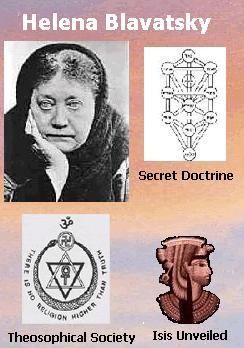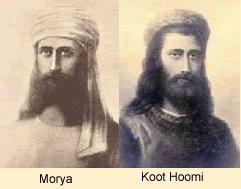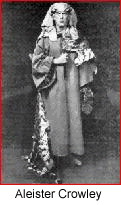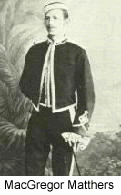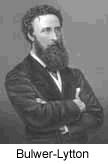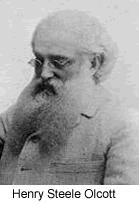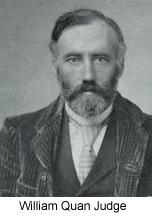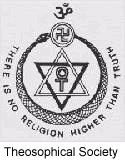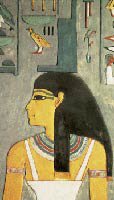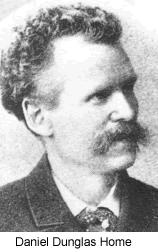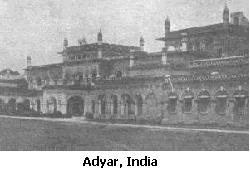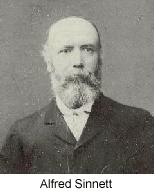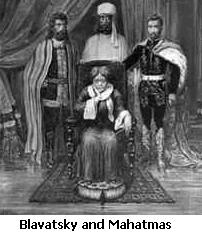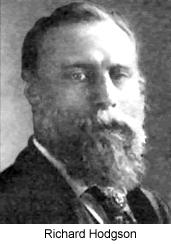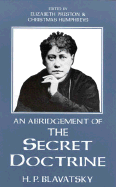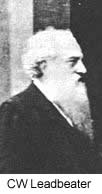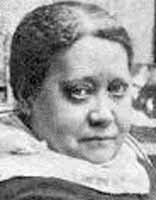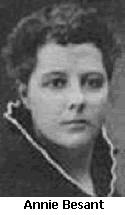Colonel Henry
Steel Olcott (1832-1907), founder and first president of the
Theosophical Society, is well-known as the first prominent person of Western
descent to make a formal conversion to Buddhism. His subsequent actions as
president of the Theosophical Society helped Buddhism into a new
renaissance. He is still honoured in Sri Lanka for these efforts. Henry
stayed in India and pursued the work of the society there. The Theosophical
society built several Buddhist schools in Sri Lanka, most notably Ananda
College, Nalanda College, Dharmaraja College and Visakha Vidyalaya. After
his death, the leadership of the society devolved onto the shoulders of
Blavatsky's protege Annie Besant.
Wikipedia: Henry Steel Olcott
William Quan Judge (1851-March
22, 1896 New York) was a mystic, esotericist, and occultist, and one of the
founders of the original Theosophical Society. He was born in Dublin,
Ireland. When he was 13 years old, his family emigrated to the United
States. He became a naturalized citizen at 21 and passed the New York state
bar exam, specializing in commercial law.
Although merely a young man, he was among the seventeen who first put the
Theosophical Society together. Like H.P. Blavatsky and Henry Steel Olcott,
he stayed in the organization when others left. When Olcott and Blavatsky
left the United States for India, Judge stayed behind to keep the Society's
work alive, all the while working as a lawyer
Wikipedia: William Quan Judge
Mabel Collins (* 9th September
1851 St Peters Port Guernsey, died 31st March 1927) was a theosophist and
author of over 46 books
Wikipedia Mabel Collins, She became a great friend of
Vittoria Cremers and Roslyn D’Onston, one of many Jack the Ripper suspects.
She got into anti-vivisection. She was deeply distressed by World War I.
During the war years Mabel visited soldiers and took an interest in military
displays. Throughout 1913/4 she spent more and more time with Catherine
Metcalfe. In 1915 she went to stay with Catherine Metcalfe and wrote Our
Glorious Future at Metcalfe's Home. Catherine Metcalfe had
contacted Mabel after returning to England from Vancouver. They were to
spend the last twelve years of Mabel’s life together. Mabel never talked of
her early life and experiences. She was approached write a history of the
rise of The TS but refused. She warned Catherine that if she
ever attempted a biography she would appear in wrath.
Mabel died of angina on 31st March 1927 at the age of 76. In her will she
left a little over £100.
Subba Row had initial problems with instructing non-Hindus. It was his
distinct belief at the time that Hindu knowledge should remain with India,
and not be extended to foreigners. In fact, even after passing over this
hurdle, he was still especially private regarding his spiritual life, even
to his mother and close friends. Unless the person he was speaking to had a
deep understanding of mysticism, it was a fairly mute topic for him.
For many years then, Subba Row was instrumental in establishing Theosophy
in India, and continued to work hard until the first draft of the Secret
Doctrine was given to him. It was his initial compulsion to edit the
piece when it had been proposed, but upon reading it, he utterly and
completely refused to have anything to do with it. It was his opinion that
the piece contained so many mistakes that he might as well be writing a
completely new book were he to edit it.
In 1888, T. Subba Row resigned from the
Theosophical Society along with J.N. Cook. Tensions between himself and many
of the members, as well as with HPB, had grown too stressful to maintain. It
was only slightly thereafter that he contracted a cutaneous disease, a
sickness which manifested itself in an outbreak of boils in 1890 during his
last visit to the Theosophical Society's headquarters in Madras. Eventually
he would succumb to the disease that year, and died on June 24, 1890, saying
that his guru had called him, and that it was time for his departure. He was
cremated the morning after as per Hindu tradition.
Wikipedia: Subba Row
A.P. Sinnett (* 18 January 1840; † 26
June 1921) was an author and Theosophist.
By 1879, Sinnett had moved to India where he was "... the Editor of The
Pioneer, the leading English Daily of India..."[2] He relates in his book,
The Occult World that: "...on the first occasion of my making Madame
Blavatsky's acquaintance she became a guest at my home at Allahabad and
remained there for six weeks..." [3]
In 1880 Helena Blavatsky and Henry Steel Olcott visited the
Sinnetts at their summer-home in Simla. The Mahatma letters, which generated
the controversy that later helped lead to the split of the Theosophical
Society, were mostly written to Sinnett or his wife, Patience.
By 1889, Sinnett was back in England, and asked Leadbeater to come back
to England to tutor his son Percy and George Arundale. Leadbeater agreed and
brought with him one of his pupils Jinarajadasa.
Sinnett was later President of the London Lodge of the Society. (ibid, A.
P. Sinnett)
C. Leadbeater His interest in occultism was stimulated by A.P. Sinnett's
Occult World, and he joined the Theosophical Society in 1883. The next year
he met Helena Petrovna Blavatsky when she came to London. "When she accepted
him [as a pupil], he gave up the church, became a vegetarian, severed all
ties with England, and followed her to India."[5]
He lived first at Adyar, and then for several years in Ceylon, where he
"...taught in a school for poor boys, founded by Colonel Olcott." (Lutyens,
p 13). Around 1889, Sinnett asked him to return to England to tutor his son
and also George Arundale. He agreed and brought with him, one of his pupils
Jinarajadasa.
He became one of the most known speakers in the Theosophical Society for
quite a number of years[7] and was also Secretary of the London Lodge.[8]
Leadbeater was accused of pederasty, the first accusation coming in 1906.
A commission was appointed by the American Section, but before the
meeting, Leadbetter resigned the TS, as he told Olcott, "to save the Society
from embarrassment." (Mary Lutyens, p 16).
Another such accusation came later from Hubert van Hook of Chicago, who
as an 11-year-old was proclaimed by Leadbeater as future World Teacher.[11]
On the denunciation, Mary Lutyens states: "Hubert later swore to Mrs Besant
that Leadbetter had 'misused' him, but as he was extremely vindictive by
that time, his testimorny, though unshaken, was perhaps not altogether
reliable.' (Mary Lutyens, p 45n)
Leadbetter was never charged or brought to court, though there is a body
of evidence that suggests he had sexual relations with students in the
United States, India and Australia. Peter Michel, in his biography of
Charles W. Leadbeater, writes that these accusations are suspect as they
came from those who could be considered his enemies
After Olcott died in Feb 1907, Annie Besant after a political struggle
became President of the Society.
By the end of 1908, the International Sections voted for Leadbeater's
His most well-known activity was the discovery, in April, 1909, of
Jiddu Krishnamurti, on the private beach that formed part of the
Theosophical headquarters in Adyar, India. Krishnamurti and his family had
been living in the headquarters for a few months before this discovery.
Krishnamurti was to be the vessel for the indwelling of the coming "World
Teacher" that many Theosophists were expecting. This new teacher would, in
the pattern of Moses, Buddha, Zarathustra (Zoroaster), Christ, and Muhammad
divulge a new dispensation, a new religious teaching. Theosophists believed
that the teacher was a spiritual being who would dwell in the body vessel.
Charles Leadbeater believed he could read past lives, and did so
on Krishnamurti who he claimed was really named Alcyone, publishing 30 such
past lives in The Theosophist beginning April 1910 as Lives of Alcyone.
"They ranged from 20,000 BC to 624 AD... Alycone was a female in eleven of
them." (Lutyens, p 25)
Charles Leadbeater stayed in India for some time overseeing the raising
of Krishnamurti, but eventually felt that he was being called to go to
Australia for the cause.
Wikipedia: C.W._Leadbeater
|
